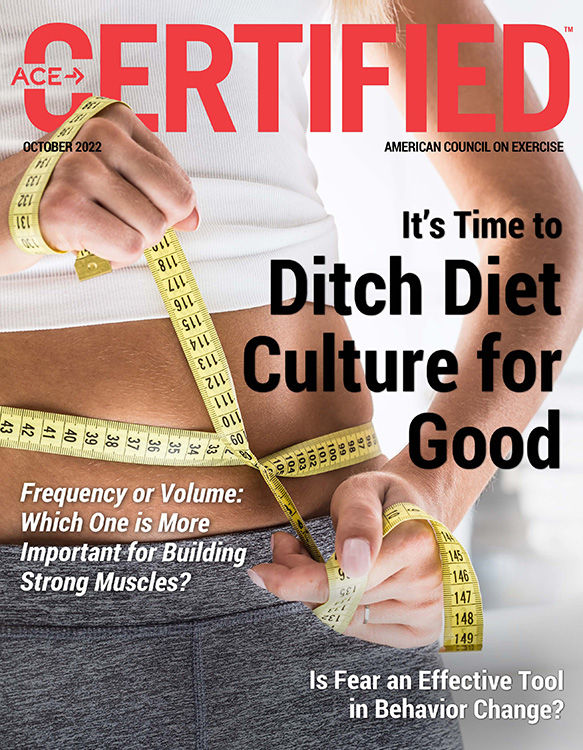
Menopause is often framed as a singular destination when, in fact, it is more like a journey, one that can be markedly different for each woman. This midlife period can be a time of profound change, both socially and physiologically, particularly for women. This is a time when many women begin to experience specific health issues, some of which are triggered by the onset of perimenopause or menopause. These issues include weight gain, fatigue, brain fog and achy joints, and fluctuating hormone levels can wreak havoc on a woman’s emotional well-being.
While not every woman will experience all these symptoms or challenges, the extended nature of the transition from perimenopause, which can start as early as one’s mid- to late-thirties, to menopause (which is reached 12 months after a woman’s final menstrual cycle, with 52 years being the average age of onset) means that many of your female clients may be experiencing its effects.
It is worth noting that women in this age group have become a frequent target of predatory, questionable “coaching” programs and supplements claiming to alleviate the wide-ranging symptoms of menopause. Taking the time to understand the specific nutrition and exercise needs of your clients throughout the various stages of life, including the menopausal transition, can help you provide meaningful, evidence-based support to your clients.
Menopause Defined
Menopause is defined as going 12 months without a menstrual period and generally occurs, on average, between the ages of 45 and 55 years. The timeframe leading up to menopause is called perimenopause and is characterized by changes in estrogen and progesterone levels, which are hormones produced by the ovaries. Women who have had their ovaries removed, often in tandem with a hysterectomy, have experienced surgical menopause, regardless of their age at the time of surgery.
Menopause is also associated with a variety of symptoms and health issues, including:
- Hot flashes
- Chills
- Trouble sleeping
- Pain during sex
- Metabolic disorders
- Obesity
- Elevated cholesterol
- Cardiovascular disease
- Osteopenia and osteoporosis
- Sarcopenia, a decrease in muscle tissue and strength
Hormonal Fluctuations and Increased Risk of Chronic Disease
Estrogen helps regulate lipids in the liver. As estrogen levels begin to decline during perimenopause, low-density lipoprotein (LDL) cholesterol and triglyceride levels may increase. Weight gain is also common during this period, and the combination of increased LDL cholesterol and excess adipose tissue can lead to insulin resistance. In other words, these hormonal changes may result in higher cholesterol levels and the onset of type 2 diabetes.
Other health issues that occur because of or during the menopausal period are osteopenia (loss of bone density) and sarcopenia. Estrogen influences how the body uses calcium, so it’s not surprising that osteopenia, which can lead to osteoporosis, is most common in women ages 50 and older.
It’s important for women who have reached this stage of life, regardless of the symptoms they may or may not be experiencing, to have labs checked regularly to monitor changes in cholesterol levels, as well as vitamin D and blood sugar/A1c. Table 1 outlines some of the common labs and tests that are used for this age group.
Table 1. Recommended Labs/Tests for Women Who Are Experiencing Menopause or Perimenopause
|
Lab/Test Name
|
Purpose
|
Can Diagnose
|
|
Glucose labs
|
Tests for blood glucose levels
|
Prediabetes or type 2 diabetes
|
|
A1c
|
Hemoglobin A1c measures average blood sugar levels over the past three months.
|
Prediabetes or type 2 diabetes
|
|
Lipid Panel
|
Total cholesterol, HDL, LDL and triglycerides
|
High cholesterol and cardiovascular disease
|
|
Vitamin D
|
Vitamin D levels
|
Can indicate if supplementation is needed
|
|
DXA Scan
|
Measures bone mineral density
|
Osteopenia, osteoporosis and sarcopenia
|
Note: HDL = High-density lipoprotein; LDL = Low-density lipoprotein; DXA = Dual-energy X-ray absorptiometry
Coaching Women Who are Transitioning Through Menopause
As mentioned earlier, a variety of physiological, social and emotional changes occur during this period of a woman’s life, which you should be mindful of when working with clients in this age group. In addition to the physiological changes previously discussed, a woman may be experiencing social changes and challenges, such as adult children leaving the home, caring for aging parents, or experiencing any number of other familial stressors. Emotionally, she may be dealing with a wide range of feelings related to growing older or a loss of fertility, feelings often exacerbated by wildly fluctuating hormones. These changes can be every bit as impactful as the physical changes she may be experiencing. As a health coach, your rapport-building skills and ability to use motivational interviewing will be crucial to uncovering your client’s needs and goals.
Setting the Coaching Agenda with Motivational Interviewing
Don’t make the mistake of assuming what your client’s intentions or goals may be for hiring you. It is essential that you take the time to ask open-ended questions, which can help guide the session and build rapport. Here are some examples of open-ended questions that you can use to set the intention for the session:
- Thanks for filling out the initial coaching questionnaire. What else would you like to discuss?
- Tell me more about what you’ve tried already. What’s worked? What do you think will be most helpful this time around?
- What concerns or questions do you want to make sure we address in this session?
- It sounds like you have a lot going on. Tell me more about what’s on your plate right now. What habits could realistically fit in with your busy schedule?
Unfortunately, social media is rife with ads touting coaching programs and supplements purported to correct “hormonal imbalance” in menopausal women. Despite the plethora of testimonials and success stories that accompany these programs and products, many of which feature expensive supplements, they may not be evidence-based. That does not mean, however, that your female clients must simply suffer through this transition. Rather, the following five guidelines consider the most common health issues related to menopause and offer proven approaches to alleviating symptoms, slowing bone loss and keeping cholesterol levels in check. And, of course, be sure to have clients reach out to their physicians or endocrinologists if they need extra support related to menopause or hormone therapy.
Challenge: Increased Risk of Insulin Resistance
Menopause may increase a woman’s risk of developing insulin resistance, which occurs when the body doesn’t adequately respond to insulin and levels of glucose in the blood go up. Individuals experiencing insulin resistance can benefit from reducing the amount of highly processed or refined carbohydrates they eat and replacing them with complex carbohydrates or low-glycemic foods. Highly processed foods include chips, crackers, cookies, sugary drinks, etc. Incorporating low-glycemic foods, such as the ones listed below, in place of these highly processed carbohydrates can make it easier for some people to manage their blood sugar levels.
Low-glycemic foods:
- Fruits: berries, apples, pears, cherries and citrus
- Vegetables: peppers, broccoli, asparagus, avocado, onions, greens and cucumbers
- Legumes: chickpeas and beans
- Dairy: milk, yogurt (with no added sugar), cottage cheese and cheese
- Minimally processed grains: whole-grain or sourdough bread and whole-grain pasta
- Other: Nuts, seeds and meat
Challenge: Increased Risk of Osteopenia and Osteoporosis
Although women in this age group are at increased risk of bone loss, it is possible to prevent the progression of osteopenia and osteoporosis with dietary and exercise changes. Osteopenia doesn’t present with symptoms, so most women don’t know they have it until it progresses and causes a bone fracture. Therefore, bone density scans (typically called a DXA scan) are highly recommended for women who are of menopausal age.
If a client learns she has osteopenia, she may be able to prevent it from progressing to osteoporosis by making some specific diet and lifestyle changes, including the following:
- Regularly perform resistance and weight-bearing training, which has been shown to increase bone density. Balance exercise is also essential, as this type of training can help reduce the risk of falls and subsequent bone fractures.
- Consume a balanced diet that is high in fruits and vegetables, proteins, dairy and whole grains, as doing so can enhance bone health.
- If a client has been advised to do so by their healthcare professional, supplementation with vitamin D and calcium, as well as vitamin K, iron and zinc, all of which are associated with bone metabolism, may help reduce fracture risk. If your client has questions about these or any other supplements, encourage them to speak with their healthcare professional.
- Eat more dried fruits, particularly prunes, which have compounds like vitamin K and potassium that have been shown to be beneficial for bone health.
Challenge: Increased Risk of High Cholesterol Levels
The hormonal changes that occur during menopause increase a woman’s risk of having high LDL cholesterol levels. Fortunately, nutritional and lifestyle changes have been shown to be effective in helping to manage cholesterol. These tips can help your clients keep their cholesterol levels in check:
- Exercise regularly, which can improve total cholesterol levels. Encourage your clients to aim for 150 minutes of moderate-to-vigorous cardiorespiratory exercise per week. If they have been sedentary, however, have them start slowly and increase over time. One of the most important things you can do to support adherence in your clients is to encourage and help them find an activity that they enjoy doing. It’s a lot easier to stick with an activity when you enjoy it.
- Increase fiber intake by eating foods such as apples, broccoli, pears, chickpeas, edamame and whole grains.
- Avoid foods high in saturated fats such as fast food, fatty cuts of meat, baked goods, etc., and instead choose foods that contain healthy fats, such as eggs, avocado, fish, nuts and seeds. Dietary fat, in moderation, can help increase satiety, which can be helpful for weight management, which also positively affects cholesterol levels.
- If a client smokes, quitting can help lower LDL cholesterol.
Challenge: Increased Tendency to Gain Weight and Fat Mass
Aging can lead to body-mass changes, especially reduced lean body mass. The combination of increased protein intake and a well-designed resistance-training program can help to preserve lean body mass and prevent sarcopenia. In fact, the researchers who conducted the Women’s Health Initiative study noted that “higher protein intake (1.2 g/kg body weight) was associated with a 32% lower risk of frailty and better physical function.” When increasing protein intake, it’s important to choose high-quality sources, such as:
- Lean beef, chicken, fish and shrimp
- Eggs and egg whites
- Cottage cheese and Greek yogurt
- Beans, peas and chickpeas
- Edamame and tofu
Challenge: Uncomfortable Hot Flashes
While there is no way to completely avoid hot flashes related to menopause, there are some ways to help minimize them. For example, avoiding spicy foods, smoking, alcohol, stress and tight clothing may help. Additionally, all the positive lifestyle behaviors we all should be following at any age—getting enough sleep, exercising regularly and eating a nutrient-rich diet—will help reduce the incidence of hot flashes, at least to some degree. If a client’s hot flashes are frequent and bothersome, encourage them to talk to their physician, as there may be prescription medications or hormone replacement therapies that can help manage symptoms.
Conclusion
Midlife and the menopausal transition is not a predictable, straight-forward journey for many women. While some pass through it with few issues, others experience life-disrupting symptoms. Yet, even when the physical symptoms are manageable, the social and emotional components can still have a profound effect on a woman’s overall well-being. Although more women are becoming open about their experiences with menopause, it largely remains a taboo topic, even among women going through it. As a health and exercise professional, you have the opportunity to provide support and encouragement to your clients, whether they are in early perimenopause or post-menopausal. Helping your clients address the health issues and symptoms related to menopause with appropriate exercise combined with a nutrient-dense diet is essential, but the simple act of listening to your client describe what she is experiencing may, at times, be what she needs most.





 by
by 


